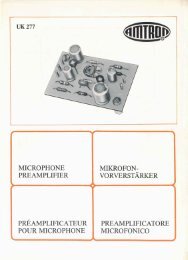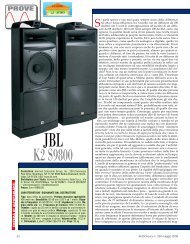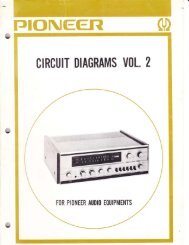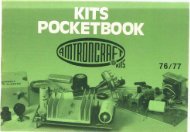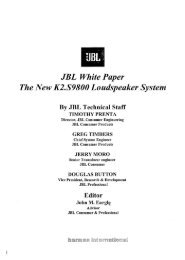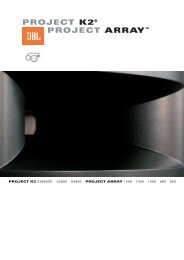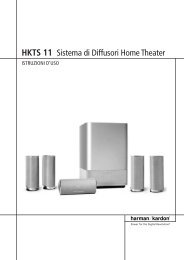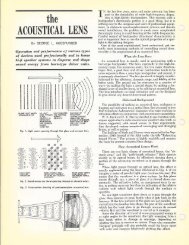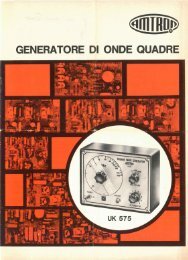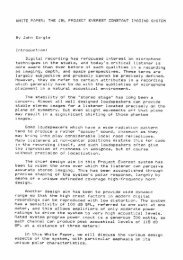Owner's manual IRS EPSILON
Owner's manual IRS EPSILON
Owner's manual IRS EPSILON
You also want an ePaper? Increase the reach of your titles
YUMPU automatically turns print PDFs into web optimized ePapers that Google loves.
Infinity Systems, Inc<br />
250 Crossways Park Dr.<br />
Woodbury, New York 11797<br />
REV 0 03/2001
Epsilon<br />
Table of Contents<br />
SPECIFICATIONS . . . . . . . . . . . . . . . . . . . . . . . . . . . . . . . . . . . . . . . . . . . . . . . . . . . . . . .3<br />
QUICK-CONNECT GUIDE FOR BALANCED INPUTS . . . . . . . . . . . . . . . . . . . . . . . . . . . . .4<br />
QUICK-CONNECT GUIDE FOR UNBALANCED INPUTS . . . . . . . . . . . . . . . . . . . . . . . . . .6<br />
SET-UP OVERVIEW . . . . . . . . . . . . . . . . . . . . . . . . . . . . . . . . . . . . . . . . . . . . . . . . . . . . . .8<br />
AMPLIFIER AND OTHER SYSTEM COMPONENTS . . . . . . . . . . . . . . . . . . . . . . . . . . . . . .9<br />
LOUDSPEAKER SETUP . . . . . . . . . . . . . . . . . . . . . . . . . . . . . . . . . . . . . . . . . . . . . . . . . .10<br />
AMPLIFIER-LOUDSPEAKER CONNECTIONS . . . . . . . . . . . . . . . . . . . . . . . . . . . . . . . . . .11<br />
<strong>EPSILON</strong> SERVO CONTROL (SCU) UNIT CONNECTIONS . . . . . . . . . . . . . . . . . . . . . . .12<br />
<strong>EPSILON</strong> SCU SETUP . . . . . . . . . . . . . . . . . . . . . . . . . . . . . . . . . . . . . . . . . . . . . . . . . . .13<br />
F<strong>IRS</strong>T TIME POWER UP AND USE . . . . . . . . . . . . . . . . . . . . . . . . . . . . . . . . . . . . . . . . .14<br />
MAINTENANCE, TROUBLE SHOOTING AND THINGS TO AVOID . . . . . . . . . . . . . . . . . .15<br />
TROUBLESHOOTING/BALANCED CONNECTION NOTES . . . . . . . . . . . . . . . . . . . . . . .16<br />
BALANCED CONNECTION NOTES/AMPLIFIER GAIN MEASUREMENT . . . . . . . . . . . . .17<br />
2
Epsilon<br />
Specifications<br />
Frequency Response:<br />
30Hz- 42kHz (±1.5dB)<br />
Recommened Power: Use with amplifiers rated between 100<br />
and 500 watts RMS per channnel<br />
Crossover Frequencies:<br />
Sensitivity:<br />
Nominal Impedance:<br />
Driver Compliment:<br />
150Hz, 500Hz, 3kHz<br />
87db @ watt/1 meter<br />
4 ohms<br />
12” (30.48cm) IMG WOOFER<br />
L-EMIM Mid-bass coupler<br />
EMIM Midrange<br />
(2) EMIT Tweeters<br />
Dimensions (H x W x D): 59¾*" x 18½" x 16¼"<br />
(151.8mm x 47mm x 41.3mm)<br />
Weight:<br />
205 lb (93kg)<br />
* Not including spiked feet. Add approximately<br />
2” for locking ring, spiked feet and cover.<br />
Total: 61¾”H<br />
IMPORTANT NOTICE<br />
There are two versions of the <strong>IRS</strong> Epsilon system<br />
The following part numbers were changed to reflect this:<br />
<strong>EPSILON</strong> LOUDSPEAKER<br />
<strong>EPSILON</strong> SCU (Servo Control Unit)<br />
<strong>EPSILON</strong> LOUDSPEAKER<br />
<strong>EPSILON</strong> SCU (Servo Control Unit)<br />
(Early) - IF30003<br />
(Early) - IF80008<br />
(Later) - IF30003A<br />
(Later) - IF80008A<br />
The two components cannot be "mixed", i.e. the early version loudspeaker cannot be used with a<br />
later SCU, or vice versa. Damage may result to the Epsilon System or to the customer's power<br />
amplifiers if this is attempted.<br />
3
Epsilon<br />
Quick-Connect Guide for Balanced Inputs<br />
4
Epsilon<br />
Quick-Connect Guide for Balanced Inputs<br />
5
Epsilon<br />
Epsilon Loudspeaker Quick-Connect Guide for Unbalanced Inputs<br />
6
Epsilon<br />
Epsilon Loudspeaker Quick-Connect Guide for Unbalanced Inputs<br />
7
Epsilon<br />
OVERVIEW<br />
Set-Up Overview<br />
This <strong>manual</strong> provides information about unpacking, locating, connecting, and using your Epsilon System. The sections<br />
about System Configuration, Amplifiers and Other System Components, and Loudspeaker Placement come before the<br />
Unpacking instructions. This is because we want you to have a clear view of the system as a whole before you begin to<br />
think about the details of connecting and using your Epsilon System.<br />
Most people prefer to minimize the handling and moving of large, heavy loudspeakers and amplifiers. When you have a<br />
clear picture of the factors affecting the placement of these components, you may be able to make some essential<br />
decisions about equipment placement and the effects on other furnishings before you unpack. This in turn may result in<br />
less overall disruption and heavy lifting.<br />
Please read this <strong>manual</strong> all the way through. Even if your dealer has done the heavy work and looked after the set-up<br />
details, we believe the <strong>manual</strong> will provide you a better understanding of your Epsilon System and the opportunities it<br />
gives you for truly superior sound reproduction.<br />
INTRODUCTION<br />
Your Epsilon loudspeakers are the result of lnfinity’s more than 25 years of research into the acoustics, operation and<br />
design of high performance loudspeakers. The design goal for Epsilon was nothing less than to achieve the highest<br />
overall level of performance, ever, from a single pair of loudspeaker enclosures. A corollary of that goal was to give<br />
them a reasonable size and an attractive appearance, important factors in making them welcome in any listening room.<br />
Each Epsilon loudspeaker employs unique Infinity technologies, including an active servo woofer system and highaccuracy<br />
planar drivers, to deliver all of the hallmarks of high fidelity sound: Wide bandwidth, high acoustic power<br />
output, uniform coverage, smooth frequency response and extremely low distortion.<br />
These characteristics enable an Epsilon system to accurately reproduce the entire frequency spectrum, dynamic range<br />
and sonic levels of the original performance. In short, Epsilon faithfully recreates the recorded performance in your<br />
listening room.<br />
The Epsilon System has three pieces: Two loudspeaker enclosures and one electronic Servo Control Unit (SCU). For<br />
operation, the Epsilon system requires a separate component stereo preamplifier (or audio control unit) and:<br />
Two stereo power amplifiers - or<br />
Four mono power amplifiers - or<br />
One stereo amp and two mono amps<br />
The Epsilon System requires two power amplifier channels for each loudspeaker enclosure: One for the servo woofer<br />
section and one for the mid/high frequency section containing the planar midrange and tweeter drivers.<br />
Each Epsilon loudspeaker’s two sections are completely separate electrically, so that there is no danger in using any<br />
amplifier combination, whether on separate or common chassis, to drive each Epsilon’s two sections or to drive both<br />
Epsilons.<br />
Each section of an Epsilon loudspeaker has a rated impedance of 4 Ohms. If you are using amplifiers that have output<br />
transformers, such as tube-type amps, or solid-state amps that have output transformers, such as those built by<br />
McIntosh Laboratories, connect the speaker cables to the “4 Ohm” outputs of the amplifiers.<br />
The Epsilon Servo Control Unit goes between the preamplifier/control unit and the power amplifiers. Because the<br />
woofer is an active servo type, an electronic feedback signal returns to the SCU from the loudspeaker via a special<br />
cable supplied with each speaker.<br />
8
Epsilon<br />
Amplifier and Other System Components<br />
AMPLIFIERS AND OTHER SYSTEM COMPONENTS<br />
Overall Component Quality<br />
Your Epsilon System is one of the finest loudspeaker systems ever made. You and your Epsilons deserve supporting<br />
audio components of the highest quality. Audio systems are highly synergistic - excellent sound quality in any one<br />
component can raise the overall performance of the other components connected to it, while poorer quality can seem to<br />
diminish the overall result more than you would expect. Choose your other system components with the same care you<br />
have devoted to selecting the Epsilon System.<br />
Wiring<br />
System cables, wiring, and connectors have come to occupy a central position in audiophile discussions about sound<br />
quality. We make no recommendations about specifics of cables and interconnects, except to note that the power<br />
transfer between the amplifiers and speakers should be as efficient as possible. This means using heavy gauge, low<br />
impedance speaker cables. There is no substitute for personal experience in the selection of audio components, and<br />
nowhere is this more true than in choosing cables and interconnects.<br />
Important amplifier specifications<br />
You will need to know the overall maximum voltage gain, in decibels (dB), for each of your power amplifiers, and you<br />
also will need to know if each is phase inverting or non-inverting from input to output.<br />
Correct set-up and operation of the Epsilon Servo Control Unit depends upon this information. Your dealer will have, or<br />
can find out, this information. Check the specification sheets and/or <strong>manual</strong>s for amps you already own; if this<br />
information is not provided, contact the dealer or the manufacturer. We will refer to these specifications again in the<br />
Servo Control Unit Set-up section of this <strong>manual</strong>, and also in the Appendix: Amplifier Gain Measurement/Setting.<br />
If any of your amplifiers have balanced input connections, you also must know if the balanced connector conforms to<br />
AES standards for signal polarity. See the Servo Control Unit Set-Up section of this <strong>manual</strong>, and also the Appendix:<br />
Balanced Connection Notes.<br />
Amplifier gain requirements<br />
If your amplifiers are not all identical, please verify that the amplifiers meet the following gain requirements:<br />
• The gains of the two woofer amplifiers must be nearly identical, within a fraction of one dB.<br />
• The gains of the two mid/high amplifiers must be nearly identical, also within a fraction of one dB.<br />
• The gains of the two amplifiers (woofer and mid/high) that drive an Epsilon loudspeaker’s two sections must be<br />
the same, or be adjustable to be the same within 6dB.<br />
If you are not sure if your amplifiers meet these basic gain requirements, please consult your dealer and read the<br />
Appendix: Amplifier Gain Measurement/ Setting, for background about this issue.<br />
How much amplifier power do you need?<br />
The amount of power needed to drive the Epsilon loudspeakers depends upon how loudly you listen. The electronic<br />
servo woofer system inherently compensates for the natural low-frequency roll-off of the woofer section. Because of<br />
this, the woofer section can require substantially more amplifier power than the mid/high frequency section for a given<br />
loudness. This is especially true when the program material has large amounts of low-frequency energy, such as organ<br />
pedal tones, large drums or synthesized bass sounds.<br />
Minimum power requirements<br />
We recommend that the power amplifiers you use have minimum power ratings of 75 Watts per channel, continuous, for<br />
driving the mid/high frequency section and 150 Watts per channel, continuous, for driving the woofer section. Some users<br />
will find these minimums insufficient, while others will wonder why anyone would need larger amplifiers. Your listening<br />
habits, the size and acoustics of your listening room, and your personal views will determine how much power you need.<br />
9
Epsilon<br />
Maximum power<br />
Loudspeaker Set-up<br />
As a practical matter, there is no upper limit on the power of the amplifiers you can use with the Epsilon System. If you<br />
always listen at moderate levels, you can easily end up with amplifier power you never use. If you often listen at<br />
concert levels or beyond, then high power amplifiers (250W/ch and more) yield immediate dividends in dynamic range<br />
and clarity.<br />
Your Epsilon loudspeakers are capable of stunning sound pressure levels. If your music begins to sound bad at<br />
elevated listening levels, and these are the levels you require your system to reproduce, more than likely you have<br />
exceeded the capabilities of your amplifiers and not those of your Epsilon speakers.<br />
Placing the amplifiers<br />
Audiophiles often prefer to place the power amplifiers close to each loudspeaker, to eliminate power losses and<br />
distortions that can result from long speaker cable runs. Many prefer to locate the amplifiers midway between the<br />
speaker pair as a means of optimizing both proximity and aesthetics.<br />
Placing the Servo Control Unit<br />
The Epsilon SCU is best placed near your preamplifier/control unit, since the SCU contains controls which affect overall<br />
sonic balance.<br />
Servo feedback cable<br />
The servo feedback cable supplied with each speaker is 50 feet (15m) long. It employs a special female 4-pin “XLR”<br />
type audio connector at each end. The 50’ length should be ample for most installations. If you need longer servo<br />
feedback cables, please contact your dealer for assistance.<br />
Cable lengths<br />
Please do not cut or order any cables to a finished length until you have determined the exact locations for all of your<br />
components. Cables that are too long rarely create problems (except for vastly too-long speaker cables), but cables<br />
that are too short are one of life’s sharper irritations.<br />
LOUDSPEAKER SET-UP<br />
Once you’ve unpacked the speakers and they are upright, you must perform several steps prior to connecting them for<br />
use. These steps require access to the rear of each loudspeaker. If the initial positions you have selected for the<br />
speakers do not permit easy access to their rear panels, set them in a position which gives you access for the following<br />
set-up and for cable connections.<br />
Battery Installation<br />
Each Epsilon loudspeaker’s high frequency driver crossover network capacitors are electrically biased with a DC voltage<br />
supplied by two common alkaline 9V snap-top batteries, NEDA type 1604A. The DC bias supplied by these batteries<br />
offers a subtle but important improvement in sound quality. While the speakers will seem to work normally without the<br />
batteries installed, the best sound quality is achieved with the batteries in place.<br />
The current drain from the batteries is extremely low, enabling them to last nearly as long as if they were sitting unused<br />
on the shelf. For this reason, we recommend the use of “alkaline” batteries rather than ordinary carbon-zinc or “heavy<br />
duty” zinc-chloride batteries, which have shorter shelf lives. Do not use rechargeable batteries of any kind.<br />
At the bottom rear of each Epsilon, to the left of the input terminals, is a brass access panel held in place by four<br />
knurled screws. This panel provides access to the battery compartments and to three switches that provide tonal<br />
balance adjustments for the loudspeaker’s EMIT, EMIM and LEMIM drivers.<br />
10
Epsilon<br />
Amplifier-Loudspeaker Connections<br />
Remove the four screws and the access panel from each Epsilon and place them out of the way. Observe that the<br />
battery snaps are female and male, and mate with the battery compartment snaps of the opposite sex. Place one 9V<br />
battery into each battery compartment by inserting the snap-top of the battery into the upper end of the compartment.<br />
Once the snaps are aligned, push up and in on the bottom of the battery, so that all of the snaps mate properly and the<br />
battery seats inside the compartment.<br />
Battery maintenance<br />
For best operation, the batteries should be changed approximately every two years, well before they are fully<br />
discharged. They can be removed by prying out their bottom ends and then pulling them down with your fingers to<br />
unsnap the connections.<br />
Initial balance switch settings<br />
Place each of the three balance switches in its FLAT position. You will most likely want to experiment with these<br />
switches once your system is fully connected and operating, so do not replace the access door yet.<br />
Place the speakers near the initial positions you have chosen, leaving sufficient room behind them to make the cable<br />
connections.<br />
AMPLIFIER-LOUDSPEAKER CONNECTIONS<br />
Speaker wire polarity<br />
All speaker wires are marked with symbols, color stripes, different color insulation or different color conductors (for<br />
example, copper and silver) to identify which conductor is which, at each end. This simple convention prevents<br />
inadvertent reversals of polarity that can cause serious audible artifacts and poor sound quality.<br />
Unless otherwise indicated, this <strong>manual</strong> assumes that the “+”, copper, red, or striped conductor in a wire-pair is the “+”<br />
conductor and connects to the red, “+” or “4 Ohm” terminals of the amplifiers and speakers.<br />
Epsilon input terminals<br />
The Epsilon’s HIGH PASS and LOW PASS input terminals accept most of the speaker-wire terminations currently in<br />
use. If you have wires with unusual connectors or terminals that don’t fit the Epsilon inputs, please seek assistance<br />
from your dealer. The input terminals’ knurled posts provide plenty of grip for finger-tightening the connections. Do not<br />
use pliers to tighten the posts; you could damage them or strip their threads, making it impossible to undo the<br />
connections.<br />
Amplifier output terminal identification<br />
Amplifiers have a variety of identifications for output terminals. Most solid-state amps have just two output terminals per<br />
channel; often these are red and black terminals, or screw-type terminal strips. Amps with output transformers have<br />
several output terminals, usually identified by the speaker load impedance they are intended to drive, such as 4Ω or 8Ω,<br />
and also a common terminal.<br />
In this <strong>manual</strong>, we call the amplifier output terminals “+” and “-”, meaning that the “+” terminal is the red, “4Ω”, or “+”<br />
terminal, and the “-” terminals is the black, “common”, ground, or “-” terminal. When the amplifier has output terminals<br />
for more than one speaker impedance, always use the “4Ω” terminal for the “+” connection.<br />
Amplifier phase (polarity)<br />
The connections from the amplifiers to the Epsilon loudspeakers’ LOW PASS and HIGH PASS input terminals depend<br />
on the phase of the amplifiers’ outputs referred to their inputs. Amplifiers are either inverting or non-inverting; that is,<br />
their outputs either go positive when the inputs go positive (non-inverting), or their outputs go negative when the inputs<br />
go positive (inverting). In the first case, the inputs and outputs have a phase relationship of approximately 0°; in the<br />
second the phase 1 relationship is approximately 180°. We use the terms “polarity” and “phase” interchangeably when<br />
we discuss this 0°/180° relationship.<br />
11
Epsilon<br />
Epsilon Servo Control Unit (SCU) Connections<br />
Regardless of the phase combination, always connect the woofer amplifiers as described below:<br />
Woofer amplifier to Epsilon LOW PASS (woofer) terminals<br />
Connect the “+” terminal of the left channel woofer amplifier to the red LOW PASS terminal of the left Epsilon (the<br />
speaker to your left as you face them from the listening position). Connect the “-” terminal of the left channel woofer<br />
amp to the white LOW PASS terminal of the left Epsilon. Repeat the connections for the right woofer amplifier and right<br />
Epsilon.<br />
The mid/high section amps connect in one of the two following ways:<br />
Mid/High frequency with non-inverting amplifier, to Epsilon HIGH PASS (mid/high) terminals<br />
Connect the “+” terminal of the left channel mid/high amplifier to the red HIGH PASS terminal of the left Epsilon.<br />
Connect the “-” terminal of the left channel mid/high amp to the white HIGH PASS terminal of the left Epsilon. Repeat<br />
the connections for the right mid/high amplifier and right Epsilon.<br />
Mid/High frequency with inverting amplifier, to Epsilon HIGH PASS (mid/high) terminals<br />
Connect the “+” terminal of the left channel mid/high amplifier to the white HIGH PASS terminal of the left Epsilon.<br />
Connect the “-” terminal of the left channel mid/high amp to the red HIGH PASS terminal of the left Epsilon. Repeat the<br />
connections for the right mid/high amplifier and right Epsilon.<br />
<strong>EPSILON</strong> SERVO CONTROL UNIT<br />
CONNECTIONS<br />
CAUTION: Turn off the AC power to all components<br />
and switch the SCU to standby mode before making or<br />
breaking any signal or power connections.<br />
SCU AC power connections<br />
The Epsilon SCU employs a power connection module<br />
that receives AC power from the wall via an “IEC” connector like<br />
Figure 1.<br />
the ones found on virtually all computers and electronic<br />
instrumentation. The module also contains the SCU’s line fuse and a plug to select its operating voltage. Figure 1.<br />
shows the details of the fuse mounting and the voltage selector. The SCU operates equally well on 5Ohz or 6OHz AC<br />
power.<br />
Voltage and fuse ratings<br />
Before you connect the power cord to the SCU, please verify that the correct voltage for your power service shows<br />
through the small window in the front of the fuse block. The table below shows the correct fuse rating for the various<br />
voltage ratings. The SCU’s AC voltage input can be set to one of four values: 100V, 120V, 220V, and 240V. If the<br />
voltage rating is already correctly set, then the fuse rating probably is correct also. If not, then replace with correct fuse.<br />
AC Line Voltage . . . . .Fuse rating . . . . . .Fuse type<br />
100 or 120 . . . . . . . . . .500mA (1/2A) . . . . .FSF, 5x20mm (Bussman type GMC)<br />
220 or 240 . . . . . . . . . .250mA (1/4A) . . . . .same as above<br />
Changing the voltage selector or fuse<br />
To change the voltage selector, or to check or replace the fuse, always unplug the power cord at the SCU before you access the<br />
fuse and voltage selector. Insert the blade of a 1/8 (3mm) flat-blade screw driver into the small opening between the power cord<br />
receptacle and the fuse block. Press the blade toward the fuse block to release the locking tab and pry out the fuse block.<br />
12
Epsilon<br />
Epsilon SCU Set-up<br />
The fuse protrudes from the rear of the voltage selector plug. Remove it to check its rating. To change the voltage<br />
selector, pull the gray selector plug out of the fuse block, turn it so that the correct voltage marking is up, and plug the<br />
selector back into the fuse block. (NOTE: The SCU has been shipped in the 120V position. The fuse for the 220V and<br />
240V position is in the compartment adjacent to the active fuse in the fuse block). Verify that the correct voltage reading<br />
shows in the window. Replace the fuse by inserting it into the rear of the selector plug, then plug the fuse block back<br />
into the power module.<br />
We recommend that you plug the SCU into a wall outlet that is unswitched and always “hot,” so that the SCU’s amplifier<br />
circuitry can remain warmed-up and stabilized for best sound quality.<br />
Signal connections<br />
The SCU has inputs and outputs for both balanced and unbalanced configurations. The unbalanced connections are<br />
standard “phono” type connectors, while the balanced connections are “XLR” types commonly used for low-impedance<br />
microphones. The input and output connections to and from the SCU may be all balanced, all unbalanced, or any<br />
combination of balanced and unbalanced.<br />
We recommend that you use the balanced connections if available on your other equipment; but if you do, please see<br />
the Appendix: Balanced Connnection Notes. This <strong>manual</strong> assumes that all of your balanced connections conform to<br />
AES standard wiring, in which pin 1 is ground (common), pin 2 is “+” and pin 3 is “-”. It is vital that you know whether<br />
the amplifiers conform to AES standards or are polarity reversed.<br />
Inputs to the SCU<br />
Connect the preamp/audio control center’s left and right channel outputs to the SCU’s left and right input connectors.<br />
Be certain to connect left channel to left and right to right.<br />
Outputs to the Mid/High Frequency Amplifiers<br />
Connect the SCU’s left and right bypass outputs to the left and right channel inputs, respectively, of the amplifier(s)<br />
that drive the Epsilons’ HIGH PASS inputs for the Mid/High frequency section.<br />
Outputs to the Woofer Amplifiers<br />
Connect the SCU’s left and right bass out outputs to the left and right channel inputs, respectively, of the amplifiers<br />
that drive the Epsilons’ LOW PASS inputs for the Woofer section.<br />
Servo connections from the loudspeakers to the SCU<br />
Plug one end of the special 4-pin XLR servo cable into the left loudspeaker’s SERVO output jack. Plug the other end<br />
into the SCU’s left servo input jack. Repeat these connections for the right speaker’s SERVO output and the SCU’s<br />
right servo input jack.<br />
WARNING: DO NOT connect the right speaker’s SERVO output to the SCU’s left servo jack or vice versa.<br />
Incorrect hook-up can lead immediately to woofer and/or amplifier failure.<br />
You may now move the speakers into their initial positions for listening evaluation.<br />
<strong>EPSILON</strong> SERVO CONTROL UNIT SET-UP<br />
Amplifier gain matching<br />
Now that the system cable connections are complete, it is time to set-up the controls on the SCU. This is when we<br />
must consider the gain specification of the various amplifiers.<br />
Basic to the operation of the Epsilon System is that the gains of the two woofer amplifiers be nearly identical, within a<br />
fraction of one dB, and that the gains of the two mid/high amplifiers be nearly identical, also within a fraction of one db.<br />
13
Epsilon<br />
First-Time Power-up and Use<br />
It is also basic to system operation that the gains of the two amplifiers (woofer and mid/high) that drive an Epsilon’s two<br />
sections be the same, or be adjustable to be the same, within 6dB if possible.<br />
The SCU’s front panel bass level control enables you to adjust the level of the low frequency section to achieve<br />
satisfactory tonal balance between the two sections.<br />
If your amplifiers for the two sections do not have gains that match within 6 db, or are not adjustable to this degree of<br />
gain matching, consult your dealer for assistance. You may need different amplifiers or an external level control. This<br />
will allow more “bass level” adjust range.<br />
Setting the SCU rear-panel phase switch<br />
The signal phase of the SCU’s electronic woofer servo control circuitry must match that of the woofer amplifier. The<br />
SCU’s phase switch provides this matching. If the woofer amps are non-inverting, set the phase switch to the 0<br />
position. If the woofer amps are inverting, set the phase switch to the 180 position.<br />
WARNING: The SCU’s phase switch must be correctly set for the amplifier in use. Incorrect setting of this<br />
switch can lead immediately to woofer and/or amplifier failure.<br />
If you are unsure of the amplifier’s phase, by all means, check it or have it checked. If you are using balanced XLR<br />
inputs on the amplifier, it is imperative that you check its conformance to AES standard wiring of the connector.<br />
Setting the SCU rear-panel dB gain control<br />
The gain of the SCU’s woofer servo control circuitry must match that of the woofer amplifiers. The SCU’s dB gain<br />
control provides this gain matching for amplifier gains ranging from 21dB to 39dB. If your woofer amps’ gains fall<br />
outside of this range, and cannot be adjusted to be within this range, please see you dealer for assistance. You may<br />
need different amplifiers or an external level control.<br />
The top-center 0 setting matches a woofer amplifier gain of 27dB. If your woofer amplifier gain is lower than 27dB,<br />
increase the dB gain control setting (clockwise) by the difference between your woofer amps’ dB gains and 27dB.<br />
Similarly, if woofer amp gain is higher than 27dB, decrease the dB gain control setting (counter clockwise) by the<br />
difference between your woofer amps’ dB gains and 27dB.<br />
Setting the SCU front-panel controls<br />
Initially, set the front-panel bass contour, mid-bass contour, and bass level controls to their top-center, 0dB positions.<br />
We will discuss the use of these controls in the following sections.<br />
You are now ready to turn the system on and listen to music.<br />
F<strong>IRS</strong>T-TIME POWER-UP AND USE<br />
Check everything!<br />
Before turning on the power to your system, confirm that all cable connections are fully and securely made, and that all<br />
switches and controls are in their recommended initial positions. Be sure that the preamp volume control is all the way<br />
down.<br />
SCU power control<br />
The Epsilon SCU power switch has two positions - standby and on. In the standby position, the outputs of the SCU<br />
are muted but the SCU’s amplifier circuitry stays powered up. The on LED flashes when the SCU is in standby mode.<br />
Since the power consumption of the SCU is quite small, there is no reason for complete shutdown. Keeping the<br />
circuitry “hot” assures stable operation and best sound quality. When you turn the power switch to on, the on LED will<br />
light steadily. About 10 seconds after this, the servo LED will light, indicating that the system is unmuted and is ready<br />
for operation.<br />
14
Epsilon<br />
Maintenance, Trouble Shooting and Things to Avoid<br />
Power-up sequence<br />
Turn on the system in sequence from signal sources to preamp to SCU to amplifiers, keeping the amplifiers for last.<br />
Turn the amplifiers on one channel or stereo amplifier at a time, and wait for each to stabilize before turning on the next.<br />
This procedure gives you time to immediately turn off the amplifier in question, if there is any unusual or loud noise<br />
resulting from incorrect connections or control settings, before damage can occur. At the end of the initial power-up, you<br />
should be greeted by silence from your system.<br />
If any loud or unusual noise occurs, quickly turn off all components and re-check all connections and SCU control<br />
settings, paying particular attention to woofer amplifier phase and the SCU’s phase switch setting.<br />
Play some music<br />
Put on a CD or LP or tape, and advance the preamp volume control. Play the system at a moderate level for a while<br />
and check that the left and right speakers are actually reproducing left and right channel sounds - a test CD with voices<br />
or sounds in each channel separately is very helpful for this. Verify that the system sounds well balanced from left to<br />
right with stereo music, and that each of the drivers is actually operating.<br />
MAINTENANCE, TROUBLE SHOOTING AND THINGS TO AVOID<br />
Remember to change the batteries!<br />
The two 9V batteries located in each speaker’s rear compartment should be changed at least every two years, well<br />
before they are fully discharged. Given their invisibility and their subtle effect on sound quality, this is an easy item to<br />
forget about, with no attention-getting reminders that the batteries need replacing. Letting the batteries fully discharge<br />
will often result in chemical damage to the batteries, their connections, and their surroundings.<br />
Since these batteries are inexpensive, you may find it convenient to change them annually, on an anniversary, or at the<br />
same time that other maintenance items around the home are performed - for example, the changing of clock batteries<br />
or the batteries in smoke detectors. A note in this <strong>manual</strong> detailing the batteries’ installation date and the next change<br />
date can help to remind you.<br />
Cleaning<br />
The Epsilon enclosures should be keep dust free - simply wipe the enclosures’ finished surfaces with a soft, clean, lintfree<br />
cloth on a regular basis. The cloth grilles covering the rear of the speakers may be lightly vacuumed with a dust<br />
brush attachment. Do not vacuum over the location of the rear-facing EMIT tweeter at the top rear of the enclosure.<br />
The front grille cloth may be lightly brushed to remove dust. Do not vacuum over the openings of the LEMIM, EMIM<br />
and EMIT drivers.<br />
Keep the case and panels of the SCU free from dust by wiping with a soft cloth and by vacuuming with a dust brush<br />
attachment.<br />
No power to the SCU<br />
If the SCU is plugged into a known live outlet (test it with a lamp or voltmeter), the power cord has no sign of damage<br />
and is plugged into the SCU, but the SCU does not power up, check its fuse by following the procedure in the Epsilon<br />
Servo Control Unit Connections, Changing the voltage selector or fuse, page 12.<br />
A blown fuse is extremely rare and is the result of a surge on the power line, the incorrect fuse, the wrong voltage<br />
setting, or the failure of a component in the SCU. If the fuse is blown, replace it with a fuse having the correct rating. If<br />
the second fuse also blows, take the SCU to your dealer for service.<br />
CAUTION: The SCU contains no user serviceable parts. Do not attempt to repair the SCU. Refer all service<br />
requirements to qualified personnel.<br />
15
Epsilon<br />
Troubleshooting/Balanced Connection Notes<br />
Damaged power cord<br />
If the power cord or one of its molded terminals is damaged, cut, has loose pins, an exposed wire or a missing ground<br />
pin, replace it at once with an equivalent cord. The SCU’s “IEC” power cord is a type commonly used with computers<br />
and electronic instruments, and is widely available.<br />
Avoid connecting and disconnecting equipment without first turning off the power to all of the<br />
components<br />
Long familiarity with audio equipment tends to make even experts casual about connecting and disconnecting<br />
equipment. Not turning off the power to each component can lead to low frequency pulses or bursts of high power<br />
noise that can damage amplifiers and/or loudspeakers. It is best to be cautious.<br />
Avoid trying to find out how loudly the system will really play<br />
This is like trying to find out how far you can stretch a rubber band - the answer is only known when the rubber band<br />
breaks. With a high performance system like the Epsilon, it is easy to play music at levels well beyond those of actual<br />
performances. Of course, it also is tempting to play some sonic spectacular as loudly as the equipment will let you.<br />
Please remember that you can damage your equipment with sustained power levels beyond those required for realistic<br />
reproduction.<br />
This is especially true when an amplifier is driven into overload (clipping) and it generates huge amounts of high<br />
frequency energy not found in any ordinary acoustic signals. This problem is most frequently encountered when<br />
amplifiers of insufficient power are used. It is hard to tell the difference between amplifier overload and loudspeaker<br />
overload, and to compound the matter, some recordings contain real sounds that can absolutely convince experts that<br />
something is wrong with the playback system.<br />
Any electronic or mechanical system can be driven to the point of failure and your Epsilon loudspeakers are no<br />
exception. After you have become familiar with your new system and have sustained listening experience with it, a<br />
doubt or a hunch that all is not well is often correct. If you have any doubts about the system’s performance, call in an<br />
expert immediately.<br />
Avoid accidentally switching the SCUs phase switch<br />
This is a really serious mistake, because it makes the feedback from the woofer to the SCU positive (regenerative)<br />
instead of negative (controlling). The result is that the system oscillates, quickly reaching the power limit of the amplifier.<br />
The audible result is horrendous noise, with a high likelihood of woofer and/or amplifier damage.<br />
BALANCED CONNECTION NOTES<br />
Many audiophile-quality components have balanced signal connections. If your equipment has such connections, we<br />
recommend that you use them. In general, they offer superior sound and lowest noise.<br />
However, some equipment made overseas has the “+” and “-” pins reversed from those specified by the standards of<br />
the Audio Engineering Society (AES), which require that pin 2 is “+” and pin 3 is “-” . If the pins are reversed, the output<br />
polarity of the signal to the speakers will be reversed from that of AES standard connections. The effects caused by this<br />
signal polarity reversal depend on whether it occurs before the SCU or in the amplifiers following the SCU.<br />
When using balanced output jacks, the rear panel gain control must be turned down by 6 db from the setting that would<br />
be used on the unbalanced output. i.e., assuming that you were using a 27 db amplifier, the rear gain control would be<br />
set to 0 db for the unbalanced mode. In the balanced mode the setting would be - 6 db.<br />
Reversed polarity prior to SCU<br />
Reversal of balanced connection polarity prior to the SCU causes no large problems as long as both channels are the<br />
same. Many audiophiles believe that absolute polarity should be maintained from the signal source to the loudspeakers.<br />
All Infinity loudspeakers are designed to deliver positive acoustic pressure when a positive signal is applied to the red or<br />
“+” terminal.<br />
16
Epsilon<br />
Balanced Connection Notes/Amplifier Gain Measurement<br />
Many electronic products, however, follow no convention about signal polarity; some invert phase, and some don’t. If<br />
you care about absolute polarity, many test CDs include impulse signals which are unipolar, that is, they are only<br />
positive-going when referenced to ground.<br />
An oscilloscope connected to the outputs of each electronic unit in the signal chain, including the CD player, can verify<br />
whether absolute polarity is being maintained. On balanced connections and a positive unipolar pulse signal, pin 2<br />
should have a positive going signal, while pin 3 should have a negative going signal. Correctly interpreting the ‘scope<br />
display often requires expertise, depending on the nature of the pulse waveform.<br />
Reversed polarity in the power amplifier(s)<br />
If the amplifiers have reversed balanced connections, then as far as the SCU is concerned, they are changed from noninverting<br />
to inverting, or vice-versa. For example, if a non-inverting woofer amp has reversed balanced connections,<br />
then from the SCUs perspective, it is an inverting amp and the SCU’s phase switch must be set to the 180 position.<br />
Furthermore, if you have amps which have mixed reversals, that is, one reversed and one not, refer to page 12.<br />
Correcting a balanced connection polarity reversal on any piece of electronic equipment is a simple matter of<br />
unsoldering and resoldering two wires on the XLR connector. This is an easy task for any technician.<br />
AMPLIFIER GAIN MEASUREMENT/SETTING<br />
Power amplifiers do just what their names imply: They take small, low-power audio signals and amplify them, increasing<br />
their power so that they drive the loudspeakers to audibly useful output levels. The amount of amplification is measured<br />
in decibels (dB) and is called gain.<br />
Many power amplifiers are fixed-gain units with no input level or sensitivity adjustments. Others have switches and/or<br />
potentiometers that adjust the input sensitivity or overall gain. As noted in the section Epsilon Servo Control Unit Set-<br />
Up, the Epsilon Servo Control Unit has a dB gain control to optimize the servo system for the gain of the woofer<br />
amplifier. When the amplifier has no input level control or gain adjustment, the SCU dB gain control is adjusted as<br />
previously described.<br />
Measuring amplifier voltage gain<br />
If you do not know the gain of each of your amplifiers with a 4 Ohm load, and cannot tell what it is from the<br />
specifications, you must measure the gain or have it measured. Then, you can use the gain or level controls, if any,<br />
along with the controls on the SCU, to match all of the amplifier gains.<br />
To measure the effective voltage gain:<br />
1. Connect a high-wattage 4 Ohm load resistor (25 Watts or more) between the amp’s “4 Ohm” and “common” output<br />
terminals.<br />
2. Apply a 1000HZ sine-wave input signal of known voltage, as measured with an AC voltmeter. The input level<br />
must be low enough so that the amplifier is not close to overload (clipping) at the output; an input level of 100mV<br />
is a good starting point. If possible, monitor the amplifier’s output with an oscilloscope to verify linear operation.<br />
3. Set all gain or level controls or switches to maximum, and measure the output voltage across the 4 Ohm load<br />
resistor.<br />
Note that maximum gain means highest sensitivity; for example, if the amp has an input switch labeled “1 V” and “2.5V”,<br />
the 1V position results in the highest sensitivity and gain. If the AC voltmeter does not have dB scales or readings,<br />
calculate the gain as follows:<br />
dB gain = 20 log (Vout/Vin)<br />
4. Check the gain of each amplifier with an input signal of 100Hz, as well. It should be virtually identical to the gain<br />
at 1000Hz; if not, note the two different readings, and use the 100Hz reading for the woofer amp and the 1000Hz<br />
reading for the mid/high amp.<br />
17
Epsilon<br />
Balanced Connection Notes/Amplifier Gain Measurement (Cont.)<br />
Setting amplifier gains:<br />
• If every amplifier has a level control, adjust each so that the amplifier has a gain of 27dB.<br />
• If none of the amplifiers has a level control, and the woofer amp and the mid/high amp gains differ by more than<br />
6dB, then you will need an external level control for the amp with the highest gain. Adjust this control so the<br />
highest gain amp matches the lower gain amp. Your dealer may be able to provide such a control for you.<br />
• If only one of the amps has a level control, and it also has the highest gain, then set it to match the lower gain<br />
amp.<br />
• If only one of the amps has a level control, and it also has the lowest gain, then you will need an external level<br />
control for the highest gain amp. Set the lowest gain amp level control to maximum and set the external level<br />
control of the highest gain amp to match the lower gain amp.<br />
18



